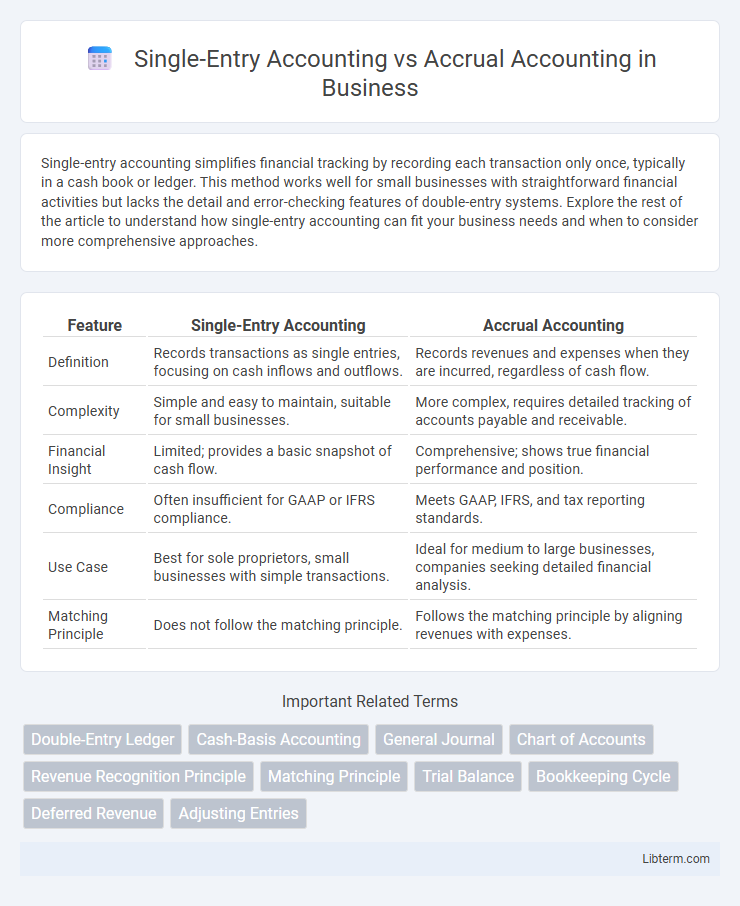Single-entry accounting simplifies financial tracking by recording each transaction only once, typically in a cash book or ledger. This method works well for small businesses with straightforward financial activities but lacks the detail and error-checking features of double-entry systems. Explore the rest of the article to understand how single-entry accounting can fit your business needs and when to consider more comprehensive approaches.
Table of Comparison
| Feature | Single-Entry Accounting | Accrual Accounting |
|---|---|---|
| Definition | Records transactions as single entries, focusing on cash inflows and outflows. | Records revenues and expenses when they are incurred, regardless of cash flow. |
| Complexity | Simple and easy to maintain, suitable for small businesses. | More complex, requires detailed tracking of accounts payable and receivable. |
| Financial Insight | Limited; provides a basic snapshot of cash flow. | Comprehensive; shows true financial performance and position. |
| Compliance | Often insufficient for GAAP or IFRS compliance. | Meets GAAP, IFRS, and tax reporting standards. |
| Use Case | Best for sole proprietors, small businesses with simple transactions. | Ideal for medium to large businesses, companies seeking detailed financial analysis. |
| Matching Principle | Does not follow the matching principle. | Follows the matching principle by aligning revenues with expenses. |
Introduction to Single-Entry and Accrual Accounting
Single-entry accounting records financial transactions as a single entry in the ledger, primarily tracking income and expenses with simplicity ideal for small businesses. Accrual accounting, by contrast, recognizes revenues and expenses when they are earned or incurred, regardless of cash flow, providing a more accurate financial picture. Both methods serve distinct purposes, with single-entry focusing on straightforward bookkeeping and accrual offering detailed financial analysis.
Key Features of Single-Entry Accounting
Single-entry accounting records each financial transaction as a single entry in a ledger, primarily tracking cash inflows and outflows, making it simple and easy to maintain for small businesses or sole proprietors. It lacks the comprehensive double-sided entries found in accrual accounting, which leads to less detailed financial statements and limited insights into liabilities and assets. This method does not account for receivables or payables, focusing instead on real-time cash management and basic record-keeping.
Core Principles of Accrual Accounting
Accrual accounting records revenues and expenses when they are earned or incurred, regardless of cash flow, ensuring financial statements reflect the true financial position of a business. It involves recognizing accounts receivable and payable, enabling better matching of income and expenses in the correct accounting periods. This core principle contrasts with single-entry accounting, which only tracks cash transactions without capturing outstanding obligations or revenues.
Differences Between Single-Entry and Accrual Methods
Single-entry accounting records financial transactions as a single entry in the ledger, primarily tracking income and expenses without capturing assets and liabilities. Accrual accounting recognizes revenues and expenses when they are earned or incurred, regardless of cash flow, providing a more comprehensive view of a company's financial position. This fundamental difference affects financial reporting accuracy, tax preparation, and decision-making, with accrual method offering detailed insight into long-term financial health.
Advantages of Single-Entry Accounting
Single-entry accounting offers simplicity and ease of use, making it ideal for small businesses and sole proprietors with straightforward financial transactions. It requires less time and fewer resources to maintain compared to accrual accounting, reducing administrative costs. Furthermore, single-entry systems provide clear cash flow tracking, enhancing immediate financial decision-making.
Benefits of Accrual Accounting
Accrual accounting provides a more accurate financial picture by recording revenues and expenses when they are earned or incurred, regardless of cash flow timing. This method improves decision-making by aligning income and expenses within the same accounting period, enhancing profitability analysis and financial forecasting. Businesses using accrual accounting benefit from better compliance with accounting standards such as GAAP and IFRS, which is essential for attracting investors and securing loans.
Limitations of Single-Entry Accounting
Single-entry accounting lacks the ability to track accounts receivable and payable, making it difficult to manage cash flow and financial position accurately. This method does not provide a complete picture of a company's liabilities and assets, limiting its usefulness for comprehensive financial analysis or for stakeholders requiring detailed reports. Its simplicity does not support complex transaction recording, often leading to errors and reduced financial transparency compared to accrual accounting.
Challenges of Accrual Accounting
Accrual accounting presents challenges including the complexity of tracking receivables and payables, requiring more detailed records and expertise compared to single-entry accounting. It demands accurate timing of revenue recognition and expense matching, which can complicate cash flow management for businesses. These challenges often result in higher administrative costs and the need for professional accounting support.
Choosing the Right Accounting Method
Choosing the right accounting method depends on the business size, complexity, and financial reporting needs. Single-entry accounting offers simplicity and ease of use, ideal for small businesses with straightforward transactions, while accrual accounting provides a comprehensive view by recording revenues and expenses when they are incurred, suitable for larger businesses requiring detailed financial statements. Understanding cash flow patterns and compliance requirements helps determine which method aligns best with your business goals and regulatory obligations.
Conclusion: Which Accounting System Is Best for Your Business?
Single-entry accounting suits small businesses with straightforward transactions, offering simplicity and low-cost record-keeping, while accrual accounting provides a comprehensive financial picture by recording revenues and expenses when they occur, making it essential for growing businesses seeking detailed financial analysis. Choosing the best accounting system depends on your business size, complexity, and regulatory requirements, with accrual accounting favored for compliance with GAAP and providing investors with accurate financial information. Businesses with limited transactions and cash-based operations may benefit from single-entry, whereas those requiring precise financial forecasting and performance tracking should opt for accrual accounting.
Single-Entry Accounting Infographic

 libterm.com
libterm.com